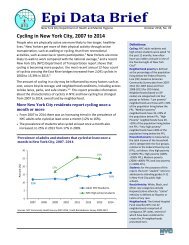2013-dot-sustainable-streets-lowres
2013-dot-sustainable-streets-lowres
2013-dot-sustainable-streets-lowres
You also want an ePaper? Increase the reach of your titles
YUMPU automatically turns print PDFs into web optimized ePapers that Google loves.
SAFETYLooking AheadNew York City must be relentless and innovative in seeking waysto continually improve its traffic safety performance. Goneare the days when concerted efforts in obviously dangerouscorridors like the Queens Boulevard or Grand Concourse ofthe 1990s can quickly drive crash and fatality numbers down.As City <strong>streets</strong> have become markedly safer, clustering ofcrashes and injuries is less pronounced, and thus more difficultto address. With the targets of safety policy becoming morediffuse, broader strategies such as deploying higher numbersof automated enforcement devices such as red light andspeed–radar cameras are likely to become more important. TheState Legislature will need a stronger understanding of thesefacts and trends to become a full partner in driving down NYCcrashes, injuries and fatalities. The next opportunity to furtherdevelop this understanding and partnership presents itself verysoon—the City’s red light camera program must be legislativelyrenewed in 2014. Ideally, the Legislature would unfettercamera enforcement programs altogether and allow the City todetermine the right size and applications for both red light andspeed enforcement camera programs.The diffusion of crash clusters notwithstanding, makinglarge arterial <strong>streets</strong> safer remains the City’s largest safetychallenge. Slow speed zones, speed humps and otherimprovements suited to smaller <strong>streets</strong> are highly popular andhave quality of life as well as safety benefits, but larger projectssimilar to the recent realignments of Adam Clayton PowellBoulevard in Manhattan and Fourth Avenue in Brooklyn willhave greater impact on the City’s overall safety performance.This fact may become even more pronounced as New York’spopulation continues to age. Such projects require extensivelocal support, explanation and outreach. The high receptivityand demand by New Yorkers for every type of street safetyimprovement program and feature augurs well for furtherimprovements in this vein.Steady erosion of the federal commitment to transportation mayhave impacts on safety programs that future City leaders willhave to grapple with. In 2012, Congress eliminated the federalSafe Routes to Schools funding program, and it is unclear how NYState DOT, which administers Federal Highway Administration aidin New York, will regard ongoing funding requests from local saferoutes to schools program’s like New York’s. U.S. traffic safetyfunding is also very constrained in its uses. NYCDOT’s safety adcampaigns would have a greater impact if they were able to bedeployed and broadcast far more broadly, but FHWA safety fundsare confined to hardware regardless of local safety needs, and insome degree distributed at the discretion of NY State. Broadeningthe uses of federal safety funds, and providing direct FHWAfunding to large cities, as strongly advocated by the NationalAssociation of City Transportation Officials, would in small partmake up for the declining amount (in both real and nominal terms)of federal transportation aid for safety and in other areas (see theInfrastructure section).– Remove state legislative restrictions on automatedenforcement cameras that improve safety, including redlight, speed, and bus lane cameras. Allow the Mayor and CityCouncil to decide the appropriate scope of these programs.– Focus additional resources on remaining high crashcorridors, especially long, wide arterial <strong>streets</strong> where safetyissues persist.– Provide more city resources for programs and streettreatments that are popular with New Yorkers, such asspeed humps, Neighborhood Slow Zones, and other trafficcalming techniques.– Change federal law to allow direct federal highway aid tocities and a broadened use of federal safety funds.Sustainable Streets: <strong>2013</strong> and Beyond59



